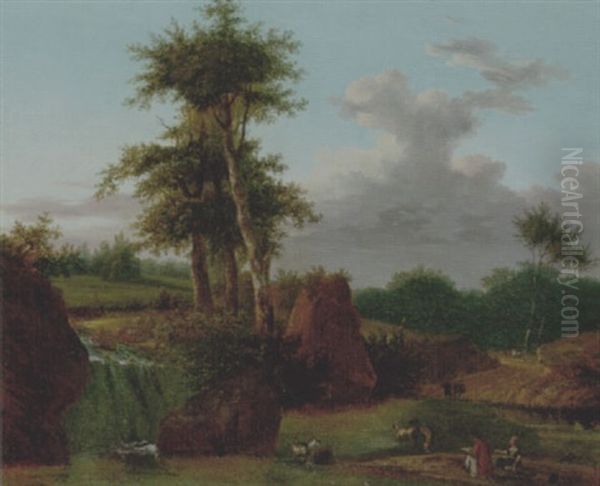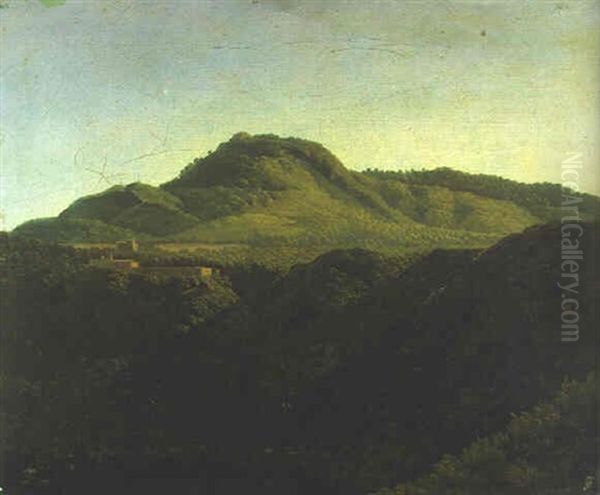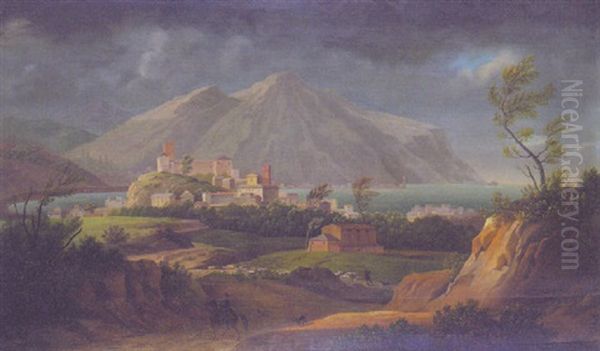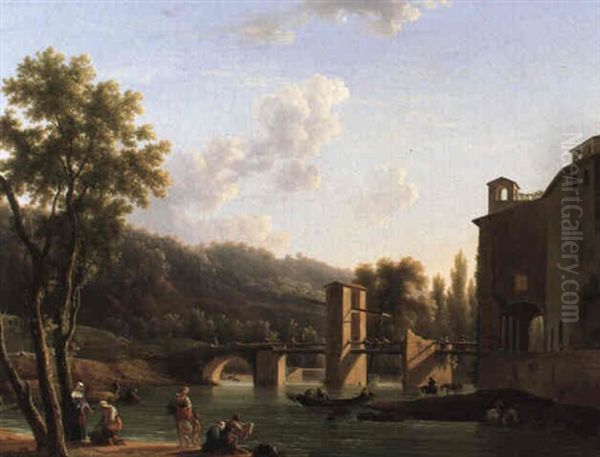
Jean-Joseph-Xavier Bidauld stands as a significant figure in the development of French landscape painting during the late eighteenth and early nineteenth centuries. Operating within the Neoclassical tradition, he dedicated his career to capturing the nuances of nature, often filtered through an idealized lens. His work, characterized by meticulous detail and a profound sensitivity to light and atmosphere, earned him recognition during his lifetime, though his adherence to established styles would later place him in contrast with emerging artistic movements.
Early Life and Artistic Formation
Born in Carpentras, France, in 1758, Jean-Joseph-Xavier Bidauld embarked on his artistic journey alongside his brother, Jean-Pierre-Xavier Bidauld, who also pursued painting. His initial training took place in Lyon, a significant provincial center for the arts. This foundational period provided him with the essential skills that he would continue to develop throughout his career. Like many aspiring artists of his time, the allure of the capital city eventually drew him northward.
Seeking broader opportunities and exposure, Bidauld relocated to Paris. This move proved crucial, immersing him in the vibrant artistic milieu of the French capital. Paris offered access to influential teachers, potential patrons, and the critical forum of the Salons, which were essential for establishing a reputation and securing commissions in the highly competitive art world of the era.
Parisian Connections and Influences
Upon arriving in Paris, Bidauld began to forge connections that would shape his artistic path. He encountered several established artists who likely provided guidance and inspiration. Among these were figures such as the portraitist Joseph-Siffred Duplessis and the renowned Jean-Honoré Fragonard, whose Rococo style differed greatly from Bidauld's eventual Neoclassical leanings but whose presence signified the rich artistic environment Bidauld entered.
He also found support from individuals outside the immediate circle of painters. The snippets mention connections with patrons like the art dealer and perfumer Dulac. Such relationships were vital for artists, providing not only financial support but also access to collectors and wider networks. Furthermore, Bidauld came into the orbit of Joseph Vernet, a preeminent landscape painter whose dramatic seascapes and Italianate views were highly influential.
The Italian Sojourn

A pivotal chapter in Bidauld's development was his journey to Italy, a near-essential experience for ambitious European artists of the period, particularly those drawn to classical themes and landscapes. Sources suggest he traveled to Italy around 1783 or 1785. His time there was substantial, lasting approximately five years, allowing for deep immersion in the country's art and scenery.
This extended stay was facilitated by the support of Cardinal de Bernis, a French diplomat and patron of the arts in Rome. Italy offered Bidauld a wealth of inspiration. He traveled extensively, spending time in Rome, the heart of the classical world, as well as exploring the landscapes of Tuscany and Umbria. During these years, he dedicated himself to sketching and painting directly from nature, capturing the unique light and topography of the Italian peninsula.
Artistic Style: Neoclassicism in Landscape
Bidauld firmly established himself within the Neoclassical movement, applying its principles to the genre of landscape painting. His style was significantly shaped by his experiences in Italy and the influence of leading Neoclassical landscape theorists and painters, most notably Pierre-Henri de Valenciennes and his earlier influence, Joseph Vernet. Bidauld sought to elevate landscape painting by imbuing it with classical order and idealized beauty.
His approach involved meticulous observation of nature, evident in the precise rendering of foliage, rocks, and water. However, this realism was often combined with an idealized composition, creating harmonious and balanced scenes. He demonstrated exceptional skill in capturing the effects of light and shadow, using them to define form and create depth. His mastery of atmospheric perspective, rendering the subtle changes in color and clarity of objects receding into the distance, was particularly noted.
While grounded in observation, Bidauld's landscapes often transcended mere topographical accuracy. He sometimes incorporated mythological or historical elements, aligning with the Neoclassical hierarchy that placed historical landscape painting above simple topographical views. This blend of detailed naturalism and idealized composition became a hallmark of his work, aiming for a timeless, elevated depiction of the natural world. The philosophical currents of the time, including the ideas of Jean-Jacques Rousseau regarding nature, may also have subtly informed his sensitive portrayal of landscapes, particularly those featuring ruins or Alpine scenery, hinting at the sublime.
Major Works and Salon Career

Returning to France, Bidauld became a consistent presence in the Parisian art world. From 1790 onwards, he was a regular exhibitor at the official Paris Salon, the most important venue for artists to display their work and gain critical attention. His submissions primarily consisted of the landscapes, often based on his Italian studies, that would define his career.
Among his representative works is A View of Tivoli Cascade, dated by some sources to 1788. This painting exemplifies his style, showcasing the famous waterfalls near Rome. Descriptions note its detailed execution, the skillful contrast between shaded foreground areas and sunlit passages, and the precise rendering of water and vegetation. Tivoli was a popular subject, allowing Bidauld to demonstrate his mastery within a recognized tradition.
Another significant work mentioned is Ideal Landscape with a Sacrifice to the Goddess Flora. This piece represents the historical landscape genre, depicting an idealized, possibly mythological scene within a carefully constructed natural setting. It highlights Bidauld's ability to blend narrative elements with his landscape skills, creating a work intended to engage the viewer on both an aesthetic and intellectual level.
Other notable paintings include Mountain View with Ruins (Vue de paysage et de ruines), cited with a date of 1827, which combines landscape with the evocative motif of classical ruins. Roman Landscape and Scenery of Cava (the latter dated 1785-1790, depicting a town in Southern Italy) further attest to the enduring impact of his Italian travels on his subject matter. These works consistently display his commitment to a high degree of finish and detailed observation.
Recognition and Later Career
Bidauld's dedication and skill gradually earned him official recognition within the French art establishment. Although he exhibited regularly from 1790, it took time to achieve the highest honors. A significant milestone came in 1792 when he received his first official commission from the state, indicating growing esteem.
His career culminated in significant accolades several decades later. In 1825, after years of consistent work and exhibition, Jean-Joseph-Xavier Bidauld was elected as a member of the prestigious Académie des Beaux-Arts in the landscape painting section. In the same year, he was awarded the Legion of Honour, France's highest order of merit. These honors solidified his position as a leading figure in French landscape painting, recognized for his mastery within the Neoclassical tradition.

Despite these successes, Bidauld's later years were marked by challenges. The artistic landscape began to shift in the early-to-mid nineteenth century with the rise of Romanticism and the precursors to the Barbizon School (referred to in one source, possibly erroneously, as the "Bazille school"). Bidauld's highly finished, idealized Neoclassical style fell somewhat out of fashion compared to the looser brushwork and more naturalistic focus of younger painters.
Sources suggest he faced criticism for allegedly obstructing the progress of this new generation of artists, perhaps through his influence within the academic system. This conflict, combined with changing tastes, reportedly led to difficulties in selling his work. Consequently, despite his earlier successes and official recognition, Bidauld experienced financial hardship towards the end of his life. He passed away in Montmorency in 1846, apparently in relative poverty.
Relationships with Contemporaries
Throughout his long career, Bidauld interacted with numerous artists. His earliest artistic bond was with his brother, Jean-Pierre-Xavier Bidauld. In Paris, he moved in circles that included Jean-Honoré Fragonard and Joseph-Siffred Duplessis. His relationship with Joseph Vernet appears to have been particularly significant, likely involving mentorship and shared travels.
The influence of Pierre-Henri de Valenciennes was crucial in shaping his approach to Neoclassical landscape. The patronage of Cardinal de Bernis and the dealer Dulac highlights his connections beyond fellow painters. Later in his career, his work was sometimes compared, perhaps contrastingly, to that of artists like Théodore Rousseau, a key figure of the Barbizon School that represented the newer trends Bidauld struggled against. One source also mentions a possible connection to the painter Drouais, though details are scarce. The artists explicitly mentioned in the provided source materials as being connected to Jean-Joseph-Xavier Bidauld are: Jean-Pierre-Xavier Bidauld, Joseph Vernet (Claude-Joseph Vernet), Jean-Honoré Fragonard, Joseph-Siffred Duplessis, Pierre-Henri de Valenciennes, Théodore Rousseau, and potentially Drouais.
Legacy and Reassessment
Jean-Joseph-Xavier Bidauld's legacy is that of a highly skilled and dedicated practitioner of Neoclassical landscape painting. While his reputation waned during his later years as artistic styles evolved, his work retained value, with pieces like Mountain View with Ruins noted for their presence in the art market.

A fuller appreciation of his contribution emerged posthumously. The discovery and study of his oil sketches and studio works revealed a more direct and spontaneous engagement with nature than sometimes apparent in his highly finished Salon paintings. These studies highlighted his keen observational skills and his role in the tradition of open-air sketching that would become central to later landscape movements. Though overshadowed for a time, Bidauld is now recognized as a key figure in French landscape painting at the turn of the nineteenth century, representing the culmination of the Neoclassical landscape tradition before the rise of Romanticism and Realism. His paintings remain testaments to a vision that sought to balance the faithful representation of nature with ideals of classical harmony and order.